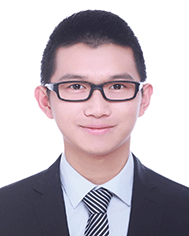Materials Horizons Emerging Investigator Series: Dr Zhengyang Bin, Sichuan University, China
Zhengyang Bin obtained his PhD degree from Tsinghua University, China in 2018, under the supervision of Prof. Yong Qiu and Prof. Lian Duan. He is now working as an Assistant Professor at the College of Chemistry, Sichuan University, China. The focus of his research is on developing structurally untraditional TADF materials for high-performance OLED devices.
Read Zhengyang Bin's Emerging Investigator Series article ‘A methyl-shield strategy enables efficient blue thermally activated delayed fluorescence hosts for high-performance fluorescent OLEDs’ (DOI:10.1039/D1MH00530H) and read more about him in the interview below:
MH: Your recent Materials Horizons Communication reports a novel methyl-shield strategy to design ideal thermally activated delayed fluorescence (TADF) hosts for the improvement of TADF sensitized fluorescent organic light-emitting diodes (TSF-OLEDs). Your strategy is applied to achieve the first example of an ultra-high-performance TSF-OLED with an EQE of above 30%. How has your research evolved from your first article to this most recent article and where do you see your research going in the future?
ZB: We are continuously focusing on developing structurally untraditional TADF materials for high-performance TSF-OLED devices due to the great potential for industrialization.
MH: What aspect of your work are you most excited about at the moment?
ZB: Firstly, we have developed a series of novel acceptors for constructing structurally untraditional TADF materials, such as heptagonal diimide (BPI), spirofluorenyl naphthalenone (SFNP) and triazolotriazine (TAZTRZ). Then, using these TADF materials, we have assembled a series of OLED devices with state-of-the-art performance, such as non-doped OLEDs, TADF OLEDs, MR-TADF OLEDs and TSF-OLEDs.
MH: In your opinion, what are the most important questions to be asked/answered in this field of research?
ZB: How can we develop structurally new TADF materials and promote their practical applications? Are there any new upconversion mechanisms for the efficient utilization of excitons in the electroluminescent process?
MH: What do you find most challenging about your research?
ZB: How to develop structurally new TADF materials and how to promote their practical applications are always very challenging during my research.
MH: In which upcoming conferences or events may our readers meet you?
ZB: I am not very sure at the moment which conferences I will join in the near future because of COVID-19. Maybe I will participate in the Pacifichem Congress and the International Symposium on Novel Aromatic Compounds.
MH: How do you spend your spare time?
ZB: I enjoy my free time with my family and friends.
MH: Can you share one piece of career-related advice or wisdom with other early career scientists?
ZB: Stay hungry, stay foolish
| This journal is © The Royal Society of Chemistry 2021 |

